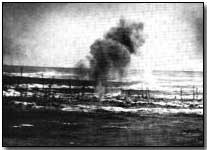Memoirs & Diaries - Destructive Technology at the Somme
 In respect to new methods and machines, the present French and British offensive
is the last word.
In respect to new methods and machines, the present French and British offensive
is the last word.
The aim of any offensive in modern warfare is the destruction of the enemy. This is the object of the present offensive, the idea being to enclose us in a tactical ring by simultaneous bombardment with long-range guns from the front and the rear.
Accordingly the greedy beast began eating at the back lines of the German front. First of all our third and second trenches were incessantly bombarded, mostly by heavy artillery, of which the enemy had concentrated unprecedented masses in the sector of attack.
It was dugouts which had to be battered down, so that at the moment of assault all the defenders, except a few survivors, and all the machine guns might be buried. Our second and third trenches were bombarded in order to prevent our bringing up reserves.
For the same reason all the communication trenches leading from the rear to the front position were kept under incessant fire. On the Somme every one of our columns had a good communication trench which led from the headquarters of the battalion to the front trench.
But the attack against our front from the rear extended still further. All the main and side roads and all the crossroads were kept under fire so that approaching troops, munitions, supplies, and provisions had to pass through several lines of fire.
Bombarding villages and places behind the front where the various reserves are supposed to be quartered is an old trick of the British and French, but this time the principle was carried out more consistently and recklessly than ever. All places up to a distance of 10 miles behind the front were brought under incessant heavy artillery bombardment, which often started actual fires, thanks to the incendiary shells used by the enemy.
The battering down of our advanced trenches was almost exclusively left to the heavy artillery and trench mortars, especially the latter. The French have made great improvements in this weapon lately. For the destruction of our trenches they exclusively employed those of the heaviest calibre, and they now throw their mines with greater accuracy and over longer ranges than formerly.
Opposite my company no fewer than six mortars were placed. They were worked uninterruptedly, throwing hundreds of aerial torpedoes on our position from the first to the third trenches. They tore up our wire obstacles from the ground, poles and all, and threw them all over the place, crushing the dugouts if they fell on them, and damaging the trenches.
In a very short time great portions of our trenches had been flattened out, partly burying their occupants. This fire lasted for seven days, and finally there came a gas attack, also of an improved kind.
The deepest impression left on me was not a feeling of horror and terror in face of these gigantic forces of destruction, but an unceasing admiration for my own men. Young recruits who had just come into the field from home, fresh twenty-year-old boys, behaved in this catastrophic ploughing and thundering as if they had spent all their life in such surroundings, and it is partly thanks to them that the older married men also stood the test so well.
Photograph courtesy of Photos of the Great War website
The first zeppelin raid on London was on 31 May 1915. Earlier raids in January 1915 had avoided London. The London raid resulted in 28 deaths and 60 injuries.
- Did you know?
